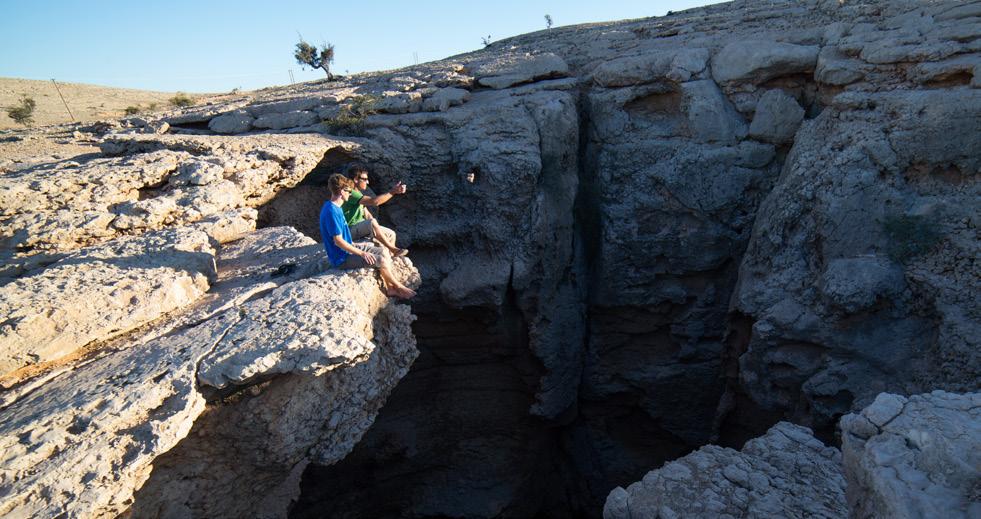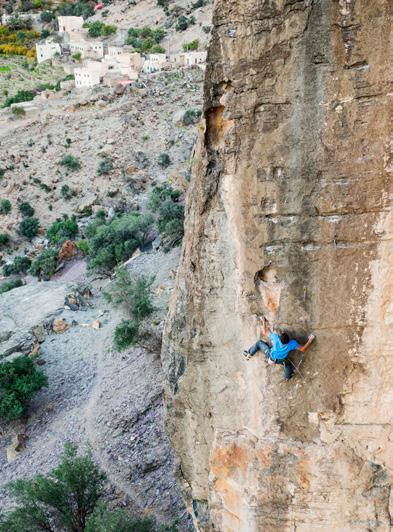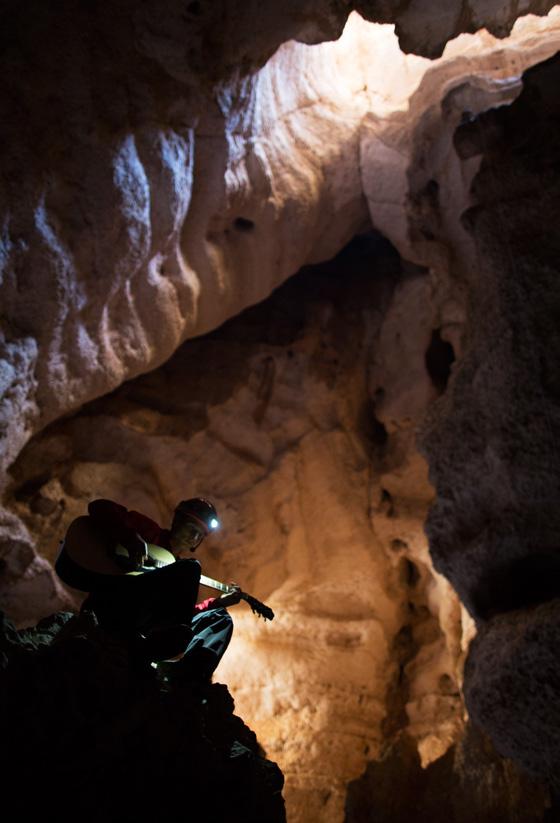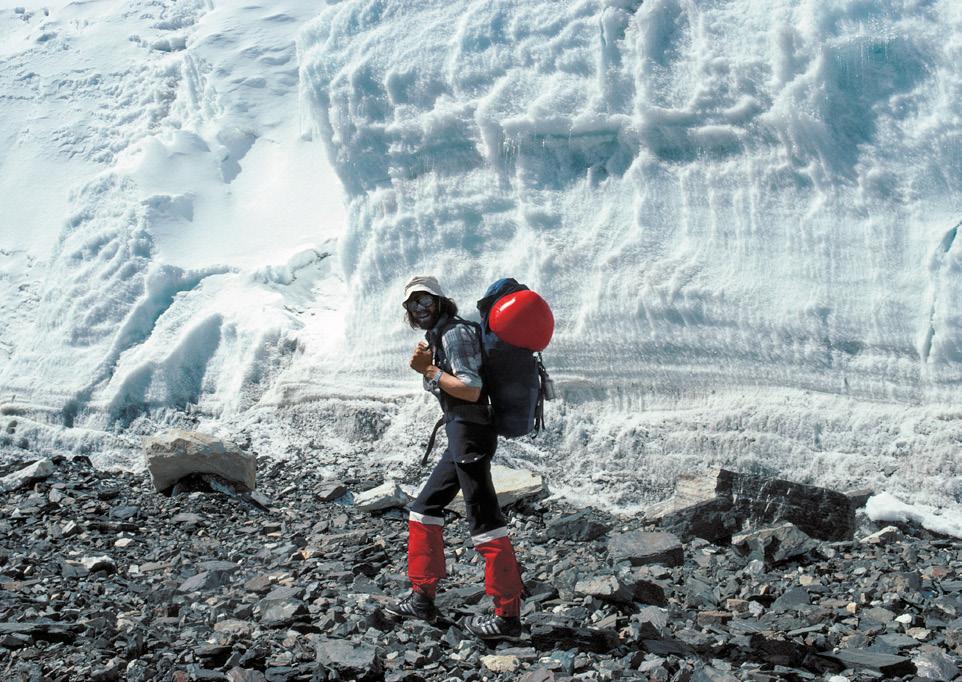
13 minute read
out of the dark
“Allah Akbar, Allah Akbar!” The call to prayer echoed across a craggy cirque in the Hajar Mountains. Jakob and I were in Oman to climb at a virtually unknown sport-climbing area near the small village of Hadash.
TEXT: READ MACADAM PHOTOS: HANNES MAIR
Advertisement
N
OMAN
To say it was scenic here would be a grievous understatement. The purple, slate crag was exposed on a shoulder of a gigantic mountainous bowl, 1,000 metres above the plains below. Below us, dirt tracks snaked across dry riverbeds and small rocky outcrops appeared lunar and minuscule against a backdrop of 2,000-metre peaks. The call to prayer rang like a testament to the majesty of it all.
Jakob pitched off the crux of his route and swore his bad beta: “Agh, I should just do that!” The route was definitely possible for him, but he seemed preoccupied with other thoughts. Back at home, his partner had recently received some distressing medical news. His mind wasn’t on the climb. I was in the same distracted head space with my route, too; I was stressed out about my own relationship breaking up. Then the weather turned to rain and the entire country of Oman was beset by a deluge. Back at the house in Muscat, the essence of freedom and time that we had hoped to experience here in Oman was feeling constricted by external pressures. But I am getting ahead of myself. Let’s go back to the beginning.
BACKGROUND Our plans began around the glow of a campfire, as good plans often do here. The thorny branches of a dead acacia tree crackled red against the needlepoint Omani sky. Jakob has spent the past ten winter seasons in Oman and I have been based here for the past six. We both came for work, but stayed for the climbing. With its jagged, rocky mountains, 1,200 kilometres of coastline and perfect climbing conditions half the year, Oman belies the common perception of a hot, desert-ridden Middle Eastern country. Within two hours of Muscat, the capital city, you can find 500-metre vertical walls, five-star sport climbs at villages straight out of an Indiana Jones movie, and dry riverbeds strewn with boulders sculpted by aeons of flash floods. There are even places to go deep-water soloing in Muscat. The country is stacked with adventurous climbing opportunities, yet largely underdeveloped and off the radar.
We sought a project that was unique to the climbing here in Oman, something different from the “usual”. We had both been dreaming of climbing in the 7th Hole cave after each visiting it independently years earlier. Dark and immense, it was the natural choice. It is hard not to be inspired by the crazy overhanging features 110 metres underground. It was important for us to climb from the ground up, using only traditional protection; no bolts, no rehearsal. A true adventure! Around the fire that night we committed time in winter 2013 to climb together. Unfortunately, with our unplanned personal dramas and a week of forced rest due to rain, we felt pressure to get up there and climb before our time ran out. Our minds raced: Would it be possible? Would the climbing be too difficult? Or would it just be completely full of water, stopping us from trying at all?
LUNAR LANDSCAPES After the rains passed, we set off up wildly exposed hairpin corners, passing ancient settlements and countless goats to reach the Selma Plateau. The road was in bad shape and we pushed the vehicle hard through terrain that would be impassable in reverse. Committed. As we crested the plateau, we encountered swirling, cold mists, but could still see the deep blue Indian Ocean sparkling 2,000 metres below us. We startled a horde of Egyptian vultures that took flight ominously over the landscape. Behind them rolling, rocky hills were dotted by lonely acacia trees. Hours later, much longer than it normally takes, we arrived at the edge of 7th Hole Cave. It was bracingly cold and damp as we exited our Jeep and walked over to peer into the cave - our base for the next couple of days.
IN THE CAVE The next morning we rigged the descent by rappel. After the requisite number of coffees we were prepared. Rappelling down the 110-metre line, the scale was indefinable as my eyes adjusted to the darkness. The first thing I noticed in the cave was the extreme contrast between light and dark. Boulders materialised from the eerie shadows created by Jakob’s headtorch, swinging back and forth like a beacon in the dark. Our intended dream line took a path through some overhangs to the right of a gigantic hanging amphitheatre. We looked up at the severely overhanging crack, buzzing. So psyched! Jakob won the paper-rock-scissors for first lead and set off with a trail of dust and stone skittering down behind him. It was not this chossy in my dreams.
READ MACADAM BORN July 1983 in North Vancouver, B.C., Canada WAS a member of the Canadian Youth Sport Climbing team 1999-2001 HAD an orange cat and much later a corporate job that he left to follow his passions IS a life coach to help people find their own passion LIVES in the Sultanate of Oman, Arabia’s hidden gem LIKES playing outside, exploring himself mentally and physically
JAKOB OBERHAUSER BORN January 1971 in Innsbruck, Austria WAS already mountaineering as a child HAD a dotted bird and many climbing friends IS a professional mountain guide LIVES in Vienna, where cultural life meets the Alps LIKES exploring and developing new areas
As Jakob reached twenty metres up the wall, I suggested to him that some protection could be worthwhile. But Jakob curtly pointed out that there was no way it would do any good; the rock was too crumbly! Jakob was excavating stones, tossing them over his shoulder as he inched upward. I considered, bemused, that it appeared as if he was picking out fruit at the supermarket, tossing the rotten fruit behind him into the darkness; the echoes reverberated throughout the cave.
Jakob soon retreated, climbing back down the precarious, friable rock (if you could call it rock). Once back on the ground, Jakob untied and we considered our lack of progress, bewildered. We had climbed a ton of chossy stone together in Oman, but this was another level. “Maybe over there?” Jakob said, suggesting a different line. No. Twenty minutes later after another attempt we plonked down, frustrated.
NEW PERSPECTIVE The atmosphere in the cave was quiet and electric. The air buzzed with the tinniest noises. We admired how the cave seemed to transform as light shifted across its cool walls. Simultaneously we both noticed a major crack, previously hidden by shadow, only now illuminated by the changed light. It descended as if from the neck of a woman silhouetted in the sky, right to the edge of the hanging amphitheatre. Exposed, direct … but possible? By now it was too late to start climbing, so we stashed our gear and made our way back to camp through the cave’s rear exit.

SUCCESS The next day, bright and early, we rappelled down into the cave once again feeling excited about the potential of this new line. The crack was exposed, guarded by a steep slope of friable conglomerate at the edge of the chasm. We set up a quick belay at the base. A fall prior to placing good protection would cause us both to tumble down into the void below. It was my lead this time. I turned on my head-torch and set off in my bubble of light. I felt the frightening pull of the abyss beneath me. What an incredible position! I traversed from up the slope along brittle conglomerate stones covered in russet-coloured dust. “Better than the day before”, I chuckled. I cleared dirt away to reveal the rock so I could place a sling and had to displace a thick cobweb. A spider the size of my hand darted out in front of my face. “Phaaa!” I almost lost it. Quickly I clipped a sling and moved on. Slowly my confidence grew as I placed another thread and started up through a run-out section toward the base of a body-width chimney. I needed to reach the perceived safety of the chimney; falling here would land me back at Jakob’s feet. Tenderly weighting and unweighting the hollow rock, I inched upwards.
“Yew!” I let out an involuntary holler as I reached the chimney. Although covered in cave dust, the rock was solid. I wedged my body against the wall and took stock of my situation. The chimney snaked upwards above me for another sixty metres, overhanging the bottom of the cave. “What a fantastic position!” I called down, but Jakob did not hear me due to the crazy cave acoustics.
Above me the chimney narrowed like an hourglass. I levered up into it and in that very moment the gear on my harness rotated around to my thighs and I was instantly stuck, feet dangling free below and hands scrambling for purchase above. The large hex bonged like a hilarious wind-chime. My helmet scraped the wall, displacing my head-torch to the side and putting me in the dark. I placed a cam with a deep breath and shuffled the rack to one side. With trust in the wedge between my body and the harness, I thrutched upwards like a caterpillar. Able to step my foot high up, I was able to awkwardly push free. Now I could rearrange my head-torch so I could see again. I continued up, covered in dust.
OUT OF THE DARK At the first belay Jakob and I laughed at the absurdity of our position: two buddies crammed into a chimney forty-five metres up in an underground cavern, looking out over a black chasm below. Above us the angle steepened, capped by a roof ending in a starburst of sunlight. It appeared steep and intimidating and I re-checked my chockstone belay as Jakob bridged his way up into the corner of the chimney and grunted as he tried to arrange a tiny thread. Finally protected, he moved out under the roof and suddenly began laughing as he tied another thread. “This is ridiculous!” He disappeared momentarily in the blinding light, before reappearing in silhouette and calling me up.
As I seconded the pitch, I was in true disbelief. The chimney was so steep that between my feet I could see the whole base of the cave spread out beneath me. Surprisingly, instead of climbing the roof I could walk out over the abyss with one leg on each side of the chimney. At the top of the pitch Jakob sat grinning ear to ear, reclined across the void. Now we were in the natural light of day.
I took the reins again, floating up the final incredible pitch of hollow calcite organ pipes, bronze coloured and glossy against the gritty pale limestone. I had the entire rack of wires and cams again, yet needed only a few slings to thread through the pipes. At the top of the headwall of pipes I climbed under a giant stone wedged in the corner and pulled myself up to the rim of the plateau. Jakob joined me and we emerged in celebration, looking like two coal miners. We had done it: the first people to free climb out of one of Oman’s amazing caves. The pressure had been released. The experience was a release.
We named our route “Climb into the Light.” Climbing from the bottom of a dark cave into the light was a great metaphor for the role that climbing plays in both our lives in general, but it felt even more appropriate due to our specific circumstances. This route recharged us for what we were dealing with in our own lives. We could not have foreseen the impact that the climb would have, yet all it took was that moment of defeat after our first attempt in the cave to realise that if we take the time to be still and just observe where we are, the light will always come and illuminate the right path.
BACK TO HADASH A few days later the sound of the muezzin rang out again, “Allah Akbar, Allah Akbar.” Jakob pulled onto his project once more. This time he flowed effortlessly through the tiny and sharp crux moves of his route, and clipped the chains on his hardest redpoint in many years. “Whooo!” He was feeling renewed and full of fresh energy and so was I as I roped up for my own project…


GEOGRAPHY Oman has a surface area of 309,500 km 2 and is the third largest country on the Arabian Peninsula, where it is located in the southeast corner. To the north, Oman borders the United Arab Emirates (UAE), to the west Saudi Arabia and to the southwest the Republic of Yemen. The peninsula of Musandam is in an interesting location, being an exclave of Oman separated by the UAE.
CLIMATE Most of Oman is desert. The high season for visitors is from the beginning of November until the beginning of March while temperatures in the valleys are between 20°C and 25°C. In summer, the temperature on the coast soars up to 45°C with extremely high humidity levels, while inland summer temperatures of 55°C and extreme dryness are not infrequent. An exception are the Dhofar Mountains at the southern end of the country: thanks to the southeast Asian monsoon, the Kharif, it rains from July to September with temperatures of 25°C and the landscape turns a lush green. Following the Kharif, the temperatures rise continuously, reaching a peak of up to 30°C January.
CLIMBING IN OMAN Most of the country’s climbing areas are located in the 600-km long Hajar Mountain Range. The area stretches from the Musandam Peninsula on the Strait of Hormuz to Ras Al Khabba (southeast of Sur) and is reached from Muscat airport by hire car - a 4WD if possible.
1. Western Hajar Mountains Here, to the west of Muscat and east of the UAE, are the most important climbing areas in Oman. Sport climbing areas like “La Gorgettes”, “Hadash” and “Kubrah Canyon” as well as the bouldering areas “Wadi Nakhal”, “Kubrah Canyon” and “Wadi Nakhar” are located here, as is the 1000-metre high wall on “Jabal Misht” and the 800-metre high “Jabal Kawr”.
2. Eastern Hajar Mountains: In the Eastern Hajar Mountains there are sport climbing areas such as “Wadi Daykah” and the “Wadi Tiwi” with its partially bolted multi-pitch routes on walls up to 400 metres high. The Salmah Plateau with the “7th Hole” is also located here.

For want of alternative accommodation, climbers usually stay in tents. Although there are no official campsites, camping is permitted throughout the country. More information on these climbing areas can be found in the climbing guide to Oman by Jakob Oberhauser: “Oman” Alpinverlag Panico (ISBN-13 978-3-95611-019-1)
DHOFAR MOUNTAINS With their one and only documented route, the Dhofar Mountains in the south of the country are still pretty much virgin territory. The potential is huge and the landscape unique. From sink holes to coastal rocks several hundred metres high and impressive sport climbing opportunities, the Salalah is waiting to be discovered. To get there, you need to fly to Salalah via Muscat. Once here, you can drive to most places in a normal car, although if you want to head out into the Rub Al Khali sands or tackle some of the wadis, a 4WD would be advisable. There are numerous hotels around Salalah, or you can camp, of course.

DUQM The Stone Garden of Duqm is worth a mention for boulder freaks who don’t mind a long journey to get there, and don’t mind the heat when they do. Located around 700 km from Muscat and 400 km from Salalah, the journey takes you to a labyrinth of blocks in the desert sand. None of the boulders here have been documented, but Read Macadam, Jakob Oberhauser and Dejan Miscovits have already checked them out.








